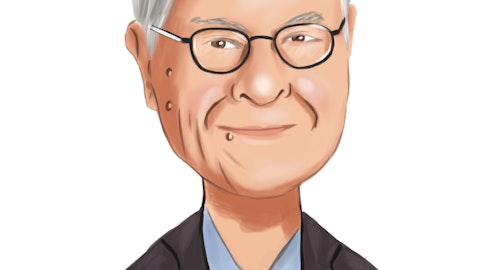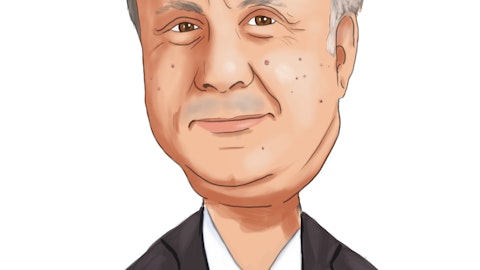Apollo Medical Holdings, Inc. (NASDAQ:AMEH) Q4 2022 Earnings Call Transcript February 24, 2023
Operator: Greetings. Welcome to Apollo Medical Holdings Fourth Quarter and Year-end 2022 Financial Results. At this time, all participants are in a listen-only mode. A question and answer session will follow the formal presentation. Please note, this conference is being recorded. I will now turn the conference over to Carolyne Sohn with The Equity Group. Thank you. You may begin.
Carolyne Sohn: Thank you, operator, and hello, everyone. Thank you for joining us. The press release announcing Apollo Medical Holdings Inc’s results for the fourth quarter and year ended December 31, 2022, is available at the Investors section of the company’s website at www.apollomed.net. To provide some additional background on its results, the company has made a supplemental deck available on its website. A replay of this broadcast will also be made available at ApolloMed’s website after the conclusion of this call. Before we get started, I would like to remind everyone that this conference call and any accompanying information discussed herein contains certain forward-looking statements within the meaning of the safe harbor provision of the Private Securities Litigation Reform Act of 1995.
These forward-looking statements can be identified by terms such as anticipate, believe, expect, future, plan, outlook and will and include, among other things, statements regarding the company’s guidance for the year ending December 31, 2023, continued growth, acquisition strategy, ability to deliver sustainable long-term value, ability to respond to the changing environment, operational focus, strategic growth plans and merger integration efforts as well as the impact of the 2020 novel coronavirus or COVID-19 pandemic on the company’s business, operations and financial results. Although the company believes that the expectations reflected in its forward-looking statements are reasonable as of today, those statements are subject to risks and uncertainties that could cause the actual results to differ dramatically from those projected.
There can be no assurance that those expectations will prove to be correct. Information about the risks associated with investing in ApolloMed is included in its filings with the Securities and Exchange Commission, which we encourage you to review before making an investment decision. The company does not assume any obligation to update any forward-looking statements as a result of new information, future events, changes in market conditions or otherwise, except as required by law. Regarding the disclaimer language, I would also like to refer you to Slide 2 of the compensation for further information. For those of you following along with the accompanying supplement, there is an overview of the company on Slide 3. On today’s call, the company’s Co-Chief Executive Officer, Brandon Sim, will discuss fourth quarter and year-end 2022 highlights and the latest operational developments.
Interim Chief Financial Officer, Chan Basho, will follow with a review of ApolloMed’s results for the year and the quarter ended December 31, 2022. Brandon will conclude the remarks with an update on the company’s outlook and long-term growth strategy before opening the floor for questions. With that, I’ll turn the call over to ApolloMed’s Co-Chief Executive Officer, Brandon Sim. Please go ahead, Brandon.
Brandon Sim: Thank you, Carolyne, and good morning, everyone. Thank you for joining us on our year-end 2022 earnings call today. 2022 was another exciting year for our company as we continued to deliver industry-leading clinical outcomes and health care experiences for our members. We achieved strong financial performance and continued to scale the business rapidly while also retaining a balanced approach towards profitability. We executed against our operational strategy in 3 key ways: one, growing our membership in core and new geographies; two, moving members along the risk ladder towards global risk value-based contracts; and three, enabling our providers to deliver excellent patient outcomes in order to manage that risk effectively; and finally, we completed several strategic transactions that we believe will support that growth strategy for years to come.
First, I’d like to summarize our strong financial results for the year. For the quarter ended December 31, 2022, we recorded total revenue of $294.2 million, an increase of 51% from $195.1 million for the prior year quarter; and adjusted EBITDA of $23.7 million, an increase of 54% from $15.4 million for the prior year quarter. For the full year of 2022, ApolloMed achieved total revenues of over $1.14 billion, an increase of 48% year-over-year; and adjusted EBITDA of $140 million, up 5% year-over-year, yielding an adjusted EBITDA margin of 12.2%, which is within our long-term target EBITDA range of 10% to 20%. This was despite headwinds due to a return to normalcy in terms of utilization and increased costs due to our investments in growth and infrastructure.
Next, I’ll briefly summarize key operational updates in the areas I mentioned earlier. Firstly, we continue to see strong organic growth in revenues from our risk-bearing member networks and our core and new geographies. Excluding any restricted Knox-Keene-related impacts, which I’ll discuss later, we view our core consolidated affiliated provider network business continuing to grow in the teens percentage points year-over-year. During 2022, we also completed the acquisition of 2 physician groups based out of Northern California, Jade Healthcare Medical Group and All-American Medical Group, which in aggregate will add over 20,000 to Medicare, Medicaid and commercial members to our risk-bearing platform in the San Francisco Bay Area. We continue to bolster the wide-ranging capabilities of our primary and multispecialty care delivery affiliate network via our network of 28 owned primary multispecialty and ancillary care delivery centers, and we see strong growth on that side of the business as well.
For example, Valley Oaks Medical Group, our brand in Nevada and Texas, has grown visits by over 20% since we closed the deal in mid-October of 2022. Secondly, we have also made great strides in terms of our ability to better engage and manage our patients via taking on greater financial responsibility for their total cost of care. We entered into a definitive agreement in late September of 2022 to acquire For Your Benefit, or FYB, an entity which is licensed by the California Department of Managed Health Care as a full-service restricted Knox-Keene licensed health plan. We remain on target to close the transaction by the end of the first quarter of 2023, pending regulatory approval. The restricted Knox-Keene license part of the FYB transaction will allow us to assume full financial responsibility in California, including both professional and institutional risk for our members’ medical costs.

Photo by National Cancer Institute on Unsplash
We believe that this will allow us to deploy our care coordination and management capabilities more effectively for those members and enhance our demonstrated ability to decrease total cost of care while improving on quality and patient outcomes. We view this as a significant opportunity for both revenue and EBITDA, but we do anticipate the process of assuming this risk level across all our members to be a gradual one, spanning several years. In terms of geographies outside of California, we continue to grow membership while retaining high-quality scores in our clinics. As a result, we anticipate being able to enter value-based arrangements outside of California with our payer partners this year. Finally, I’d like to touch on our capabilities in care and medical cost management.
We’ve now fully integrated the capabilities of Orma Health’s real-time clinical AI platform, which takes data from multiple sources and utilizes our proprietary risk ratification models to identify patients for various clinical programs that we operate, including remote patient monitoring, chronic care management and more. This clinical platform is deeply integrated with our own RPM ecosystem, which consists of smart health devices and a suite of technology tools to help manage our patients’ health. Since integrating Orma Health, which we acquired just over a year ago, we’ve been able to strengthen the connected, coordinated holistic care ecosystem that we are delivering to our patients. This, along with the ongoing development of our internal provider-facing, patient-facing and care management tools and our demonstrated historical success, give us confidence to continue succeeding in the elevated risk levels I discussed earlier.
In summary, the breadth and depth of our value-based care delivery and value-based enablement platform provide a strong foundation for growth and expansion in 2023 and beyond. I’d like to thank our providers and team members in helping us move closer to our mission of bringing high-quality, value-based care to all. With that, I’ll turn it over to Chan to review our financial results. Chan?
Chan Basho: Thanks so much, Brandon. We reported a record total revenue of over $1.14 billion for 2022, an increase of 48% from $773.9 million in 2021. Our top line growth was primarily driven by increased capitation revenue from organic membership growth at our core IPAs, a more favorable membership mix as well as our participation in value-based in a value-based Medicare fee-for-service model. On the fee-for-service side, increased fee-for-service revenue as a result of more patient visits at ApolloMed surgery and heart centers and the company’s consolidation of some clinical laboratories and diagnostic medical group. Capitation revenue increased 57% to $930.1 million during the period, accounting for 81% of total revenue in 2022.
Fee-for-service revenue increased 86% to $49.5 million from $26.6 million in the prior year. This increase was primarily due to a full year of revenue contributions from the consolidation of Sun Labs and DMG and 1.5 months of revenue contribution from Valley Oaks Medical Group. In addition, there is an increase of $3.2 million from increased visits to our surgery and heart centers. We ended 2022 with our membership at approximately 1.3 million managed lives. Approximately half of our members were under capitated risk-bearing arrangements to our consolidated IPAs. Total OpEx increased to over $1 billion in 2022, an increase of 54% from $675.7 million in the prior year. This increase was primarily due to increased cost of services due to the return to pre-COVID-19 medical expense run rates and growth in membership, which was commensurate with our increase in capitation revenue.
We also incurred higher G&A expenses related to the hiring of additional personnel to support our continued growth. Net income attributable to ApolloMed was $49 million compared to $73.9 million for 2021. Earnings per share on a diluted basis were $1.08 per share compared to $1.63 per share for the prior year, mainly due to the increase in operating expenses mentioned earlier; a $10.5 million increase in unrealized losses on investments year-over-year, which was primarily driven by a decrease in the stock price of certain investment holdings; and a $7.6 million increase in our provision for income taxes year-over-year. We reported EBITDA of $110.8 million, an increase of 11% from $99.1 million for the year ended December 31, 2021. Adjusted EBITDA increased 5% to $140 million for 2022 from $133.5 million for 2021.
We placed greater emphasis on the adjusted EBITDA figures as these numbers back out the impact of income from equity method investments, stock-based compensation and other onetime expenses. They also back out the impact of excluded assets, which for 2022 included a onetime noncash unrealized loss of $10.5 million as a result of a decrease in fair value related to the passive investment in a payer partner and unrealized loss on investments. These losses are in the excluded asset bucket that we’ve described in the past as they are solely for the benefit of our affiliate, APC, and its shareholders. Turning over to the balance sheet. We remain well capitalized and well positioned to execute on our growth initiatives. We ended the fourth quarter with $288 million in cash and cash equivalents compared to $233.1 million at the end of 2021.
Our working capital increased to $287.8 million from $283.4 million at the end of 2021. And total stockholders’ equity increased to $555 million at December 31, 2022, from $460.5 million at December 31, 2021. Moving further down the balance sheet. Total debt at the end of the fourth quarter was $204 million. As Brandon mentioned earlier, the impact of COVID provided some temporary tailwinds that had a positive impact on our results in 2021. As anticipated, these tailwinds subsided as we have returned to pre-COVID utilization levels in 2022. We’re seeing a return to more normal visit patterns for routine non-COVID-related care, impacting our medical claims costs and patient visits to the hospital for nonemergency procedures, affecting our risk pool settlements with our hospital partners.
I’d like to turn it back over to Brandon for a discussion of our growth strategy and outlook for 2023.
Brandon Sim: Thanks, Chan. I’ll first touch on guidance for 2023. As shown on Slide 10 of our earnings supplement, we are pleased to be providing the following guidance projections for this year: total revenue of between $1.3 billion and $1.5 billion, which would translate to between 14% and 31% year-over-year growth; net income of between $49.5 million and $71.5 million; EBITDA of between $89.5 million and $129.5 million; adjusted EBITDA of between $120 million and $160 million; and diluted EPS of between $0.95 and $1.20. Please note that the net income and EBITDA guidance does take into account the impact of the excluded assets that are solely for the benefit of APC and its shareholders, and we assume no change in value in these excluded assets in our guidance.
These guidance metrics also do not consider any potential acquisitions or other major business transactions we may complete in 2023. As any material developments arise, we’ll be sure to update the markets and reevaluate guidance as appropriate. We have taken a conservative approach to our guidance given several uncertainties surrounding, one, investments in new geographies; two, redetermination; and three, the retroactive trend adjustment related to the ACO reach program. Firstly, we plan to invest between $5 million and $15 million to more rapidly develop our newer geographic regions, namely in Nevada and Northern California, and enable them to grow differentially. We also plan to deploy these funds to enable our path to greater risk and value-based arrangements in those regions more quickly.
Next, with regards to redetermination, the temporary policies that came out of the COVID-19 public health emergency, such as expanded eligibility and coverage of certain services, are being rolled back or modified, which will result in some beneficiaries losing their coverage and being subject to redetermination. We estimate that this will result in 5% to 15% of our Medicaid beneficiaries losing their coverage. The state of California has taken steps to make the redetermination process more efficient and accessible and we are hoping these efforts, along with ours, will help to mitigate some of these potential impacts. Because ApolloMed serves all patients regardless of insurance type, our goal is to ensure that our members continue to receive the care they need in a seamless fashion even if their insurance coverage does change.
And finally, we experienced large variances in the ACO reach program benchmark during 2022 calendar year. Now therefore, being conservative in our assumptions associated with that benchmark until we have 1 to 2 quarters of data under our belt for 2023. Overall, we remain confident in our ability to execute on our growth strategy having better positioned ApolloMed for success with the work we have done throughout 2022. Our new leadership team, operations and BD teams and department heads have now worked closely together for over a year. And we are very excited about the growth opportunities we see before us, both organic and inorganic. I’ll also briefly mention that I will be attending the Jefferies Value-Based Care Summit and Barclays Global Healthcare Conference in Miami Beach next month.
I look forward to seeing some of you there. To close, 2022 was another milestone year for ApolloMed. We are proud to be serving all patient populations regardless of ethnicity, socioeconomic status or life circumstance. We are proud to have built a health care ecosystem that can empower our providers to deliver the best possible care and health care experience to their patients and to drive superior clinical outcomes and allow members to live their best lives possible. I would like to once again extend my heartfelt thanks to all of our ApolloMed team members across the organization who are as committed as I am to our mission. Together, we are working towards a future where all Americans can have access to high-quality, value-based and evidence-driven health care.
With that, operator, let’s open it up for Q&A.
See also 13 Most Profitable Food Stocks and 13 High Growth Pharma Stocks that are Profitable.
Q&A Session
Follow Astrana Health Inc. (NASDAQ:ASTH)
Follow Astrana Health Inc. (NASDAQ:ASTH)
Operator: Our first question is from Brooks O’Neil with Lake Street Capital Markets. Please proceed.
Brooks O’Neil: I have a bunch of questions, so I’m going to try to ask them quickly. First is, I’ve always been a little confused about the Medicare demonstration projects you guys are participating in. I know you’ve performed exceptionally well in those. Can you just give us a sense for how you think that might impact the company and the results in 2023?
Brandon Sim: Sure. Yes. Thank you. Happy to answer any number of questions. So around the Medicare innovation programs that we’re participating in, we’ve had a long history of participating in those programs and succeeding, as you mentioned, starting with the next-generation ACO program; the global and professional direct contracting program for GBDC; and the ACO reach program, which we embarked on this year. We are being fairly conservative in our estimates and guidance for the year due to some of the retroactive benchmark adjustments we saw in some of these programs last year given our experiences. But we still are great proponents of the program and are exciting participants in it. We believe that the program allows us to better manage and coordinate care for original Medicare or Medicare fee-for-service patients.
And it allows us to gradually introduce providers outside of our core regions to the concepts of coordinated value-based care. And so we have seen great growth in that segment of the business this year, and we anticipate it to continue to grow in the years to come.
Brooks O’Neil: Second question, I think I heard you, Brandon, say, the Knox-Keene license you’re about to acquire, it’s going to allow you to take full global capitation across all of California. Did I hear that correctly? And how do you think that’s going to affect the company this year?
Brandon Sim: You’re absolutely correct, Brooks. The pending regulatory approval of the transaction thestrict Knox-Keene would allow us to assume global risk, both professional or outpatient and inpatient risk, for a patient in California. There will be certain regulatory and contractual negotiations that we will need to embark on before we can roll that contract out to all of our members, but that is kind of a period of 2 to 3 years that we had guided to in order to complete that project. By the conclusion of it, you’re correct in that we would be able to assume the global risk for members in California.
Brooks O’Neil: Wow. That’s big. So one of the big issues I wrestle with a little bit, we’ve talked about is the speed of growth and the scope of growth in terms of both number of new members, new geographies. As you know, I’m a huge believer that value-based care is an opportunity nationwide. And I certainly recognize underserved populations, such as form the core of your membership, are all over this country as well. So just talk a little bit about how you’re viewing geographic expansion in 2023 and how you think it will like the company this year.
Brandon Sim: Yes. Absolutely. Thanks for asking. So there are a couple of key geographies where we think we have the ability to spur differential growth in 2023. I mentioned 2 of them earlier in terms of Nevada and Northern California. We also have entered Texas, as you know, from that same transaction in late last year. And we think that there is great opportunity to introduce further value-based care to those communities that we’re serving in those states. We plan to invest dollars into making that happen, both in terms of growing the patient population, slipping from fee-for-service to risk. And we believe that this year, we will have value-based contracts outside of California to assume risk for members’ total cost of care as a result of those investments. I’d also like to point out that our EBITDA guidance does take into account the effect of those investments that we’ll be making this year.



